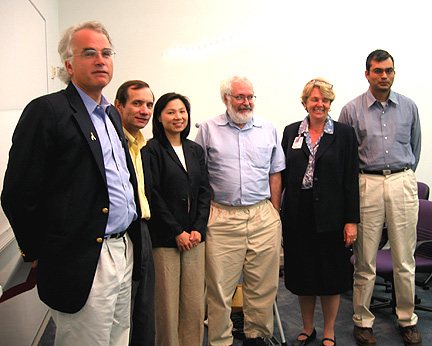
| T H E N I H C A T A L Y S T | N O V E M B E R – D E C E M B E R 2005 |
|
|
|
Research
Festival
|
by Fran Pollner |
 |
|
Non-Hodgkin's
Lymphoma Panel:
(left to right) Stephen Chanock, Michael Lenardo, Sophia Wang, Nathaniel
Rothman, Patricia Hartge, and Sandeep Dave
|
The prognosis for patients with follicular lymphoma has been notoriously
unpredictable. But gene expression profiling at the time of diagnosis, NIH scientists
are saying, may change that by revealing genes associated with good and poor
immune response and corresponding survival.
"Morphologic similarities can
mask a surprising degree of molecular heterogeneity that underlies outcome differences,"
Sandeep Dave
observed, citing outcome data related to molecular subtype gathered in Lou
Staudt's NCI lab, where he is a clinical fellow.
Subtypes of diffuse large B cell lymphoma
(DLBCL) that "look the same under the microscope" nonetheless exhibit
different oncogene mechanisms, respond differently to treatment, and carry a
different prognostic message.
Five-year survival for the ABC subtype,
which expresses NF-kB, is
31 percent; five-year survival for the GCB subtype, which does not express NF-kB, is 60 percent. NF-kB, Dave
said, might thus be a therapeutic target in the ABC subtype of DLBCL.
Dave was one of the panelists at a
Research Festival symposium that explored the expanding repositories of data
— genetic, environmental, and medical — related to the risk of non-Hodgkin's
lymphoma (NHL). The need now, they agreed, is to determine which factors and
combinations of factors can inform preventive and therapeutic strategies in
the clinical setting.
According to data from the SEER case-control
study of NHL, Sophia
Wang noted, NF-kB is indeed "emerging as a signficant player" in DLBCL
risk.
The SEER data, she said, focused on
15 single-nucleotide polymorphisms from
seven genes for inflammatory cytokines and uncovered two — TNF-G308A and
LTA-252G — that singly and, especially, in combination were significantly
associated with DLBCL. A follow-up study is exploring gene-environment interactions,
said Wang, an investigator in the Division
of Cancer Epidemiology and Genetics, NCI.
Patricia
Hartge, deputy director of the DCEG Epidemiology
and Biostatistics Program, itemized environmental and host factors that
have been implicated in the etiology of NHL — the incidence of which, in
contrast to Hodgkin's disease and independent of the advent of AIDS, with which
it is associated — has been steadily increasing since 1950.
Among risky host factors are immune
suppression; a family history of NHL, Hodgkin's disease, or multiple myeloma;
autoimmune diseases such as Sjögren's syndrome, lupus, and rheumatoid arthritis;
and hepatitis C.
Genetics, she said, may elucidate susceptibility
and mechanisms. She predicted new large epidemiological studies that would look
at survival and cause, a major advance over previous studies.
A newly described genetic disorder
of programmed cell death — autoimmune lymphoproliferative syndrome (ALPS)
— can presage lymphoma, Michael
Lenardo, a senior investigator in the Laboratory
of Immunology, NIAID, reported.
Characterized by the loss of a general
antineoplastic mechanism associated in 75 percent of cases with an FAS receptor
mutation, ALPS patients typically present with lymphadenopathy and splenomegaly
by the age of 5 — and there is typically a delay of 10 to 40 years between ALPS onset and
lymphoma.
In a study of 130 individuals in 39
families with ALPS and FAS mutations, 10 people eventually developed 11 instances
of B and T cell lymphomas, Lenardo said.
Jumping from the United States to the
world stage of molecular epidemiological data, Nathaniel
Rothman pointed to the International
Lymphoma Consortium (InterLymph), as a growing source of "solid clues
that could translate to clinical implications for survival."
Established in the late 1990s, InterLymph
has amassed data from about 9,000 cases in North America, Australia, and Europe,
said Rothman, a DCEG senior investigator.
The Genetic Polymorphism Working Group
has been studying Th1 and Th2 proinflammatory response and has found a consistent
association with lymphoma risk for haplotypes with both TNF and LTA variants
and, to a less consistent extent, with an IL-10 variant.
With the ability to conduct whole genome
scans, it will become possible to distinguish associations that are real from
those that are not, Rothman said.
Stephen Chanock, a senior investigator and head of the Genomic Variation Section, NCI, observed that the population groups most extensively studied to date are Caucasian. Asian and African groups, he said, need similar scrutiny, which will elucidate what genetic variants are common across populations and the role of environmental factors. n